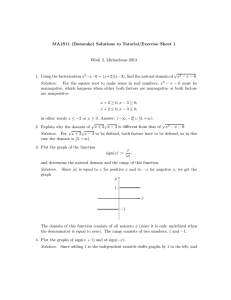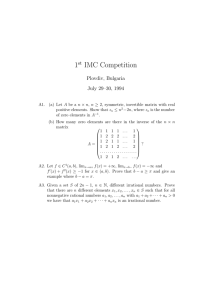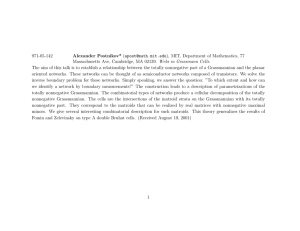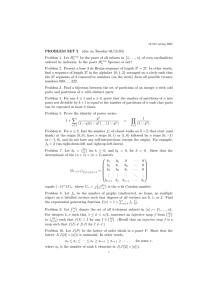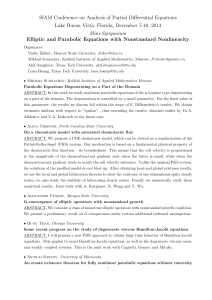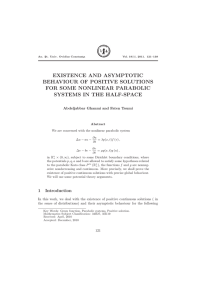Electronic Journal of Differential Equations, Vol. 2010(2010), No. 143, pp.... ISSN: 1072-6691. URL: or
advertisement
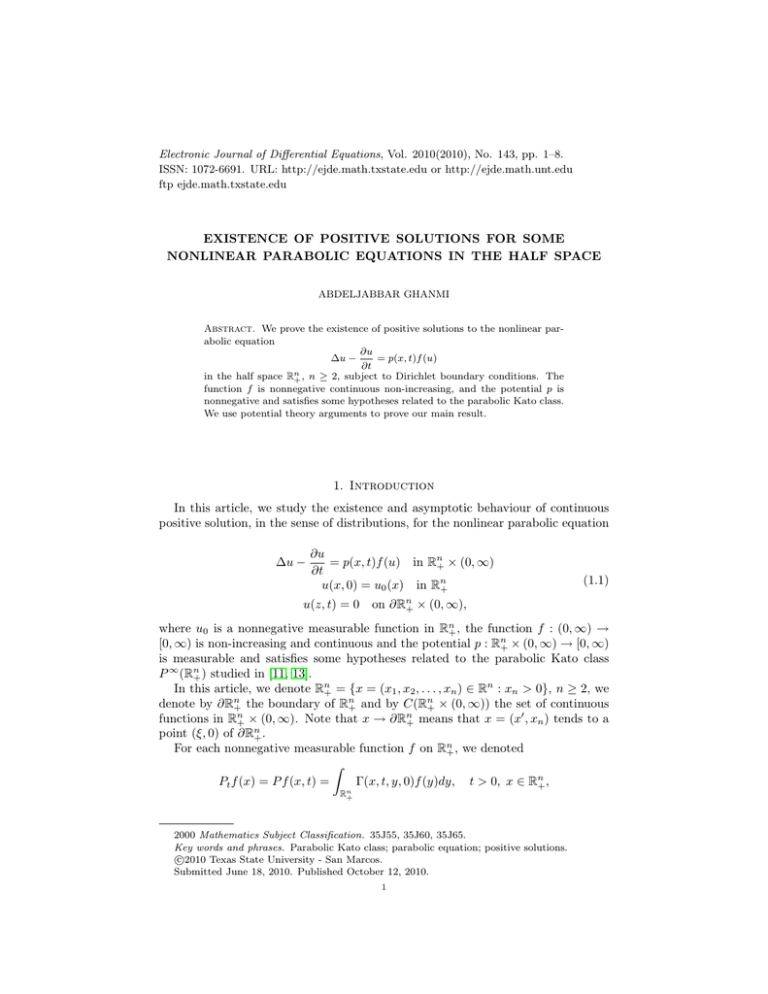
Electronic Journal of Differential Equations, Vol. 2010(2010), No. 143, pp. 1–8.
ISSN: 1072-6691. URL: http://ejde.math.txstate.edu or http://ejde.math.unt.edu
ftp ejde.math.txstate.edu
EXISTENCE OF POSITIVE SOLUTIONS FOR SOME
NONLINEAR PARABOLIC EQUATIONS IN THE HALF SPACE
ABDELJABBAR GHANMI
Abstract. We prove the existence of positive solutions to the nonlinear parabolic equation
∂u
∆u −
= p(x, t)f (u)
∂t
in the half space Rn
,
n
≥
2,
subject
to Dirichlet boundary conditions. The
+
function f is nonnegative continuous non-increasing, and the potential p is
nonnegative and satisfies some hypotheses related to the parabolic Kato class.
We use potential theory arguments to prove our main result.
1. Introduction
In this article, we study the existence and asymptotic behaviour of continuous
positive solution, in the sense of distributions, for the nonlinear parabolic equation
∆u −
∂u
= p(x, t)f (u) in Rn+ × (0, ∞)
∂t
u(x, 0) = u0 (x) in Rn+
u(z, t) = 0
(1.1)
on ∂Rn+ × (0, ∞),
where u0 is a nonnegative measurable function in Rn+ , the function f : (0, ∞) →
[0, ∞) is non-increasing and continuous and the potential p : Rn+ × (0, ∞) → [0, ∞)
is measurable and satisfies some hypotheses related to the parabolic Kato class
P ∞ (Rn+ ) studied in [11, 13].
In this article, we denote Rn+ = {x = (x1 , x2 , . . . , xn ) ∈ Rn : xn > 0}, n ≥ 2, we
denote by ∂Rn+ the boundary of Rn+ and by C(Rn+ × (0, ∞)) the set of continuous
functions in Rn+ × (0, ∞). Note that x → ∂Rn+ means that x = (x0 , xn ) tends to a
point (ξ, 0) of ∂Rn+ .
For each nonnegative measurable function f on Rn+ , we denoted
Z
Pt f (x) = P f (x, t) =
Γ(x, t, y, 0)f (y)dy, t > 0, x ∈ Rn+ ,
Rn
+
2000 Mathematics Subject Classification. 35J55, 35J60, 35J65.
Key words and phrases. Parabolic Kato class; parabolic equation; positive solutions.
c
2010
Texas State University - San Marcos.
Submitted June 18, 2010. Published October 12, 2010.
1
2
A. GHANMI
EJDE-2010/143
where Γ(x, t, y, s) is the heat kernel in Rn+ × (0, ∞) with Dirichlet boundary conditions u = 0 on ∂Rn+ × (0, ∞) given by
Γ(x, t, y, s) = (4π)−n/2
1
|x − y| xn yn exp −
(1 − exp −
)
n/2
4(t − s)
t−s
(t − s)
for t > s, x, y ∈ Rn+ .
We note that the family of kernels (Pt )t>0 is sub-Markov semi-group, that is
Pt+s = Pt Ps for all s, t > 0 and Pt 1 ≤ 1. We mention that for each nonnegative
f on Rn+ , the map (x, t) → Pt f (x) is lower semi-continuous on Rn+ and becomes
continuous if f is further bounded. Moreover, let w be a nonnegative superharmonic
function on Rn+ , then for every t > 0, Pt w ≤ w and consequently the mapping
t → Pt w is non-increasing.
The motivation for our study are the results presented in [6, 7, 8, 9, 10, 11, 12,
13, 15] and their references. Zhang [15] gave an existence result of the parabolic
problem
∂u
+ q(x, t)up = 0, in D × (0, ∞)
∆u −
∂t
(1.2)
u(x, 0) = u0 (x), x ∈ D,
where D = Rn (n ≥ 3), u0 is a bounded function of class C 2 (Rn ) and q(x, t) is in
the parabolic Kato class P ∞ (Rn ) which was introduced in [16].
Inspired by the papers by Zhang [15] and Zhang and Zhao [14], Maatoug and
Riahi introduced for the case of the half space a parabolic Kato class P ∞ (Rn+ ) and
gave an existence result for (1.2) where D = Rn+ .
Maagli et al [11] studied the problem
∂u
= 0 in Rn+ × (0, ∞)
∂t
u(x, 0) = u0 (x), x ∈ Rn+
∆u − uϕ(., u) −
u=0
in
∂Rn+
(1.3)
× (0, ∞),
where u0 is a nonnegative measurable function defined on Rn+ and satisfies some
properties which allows u0 to be not bounded, the perturbed nonlinear term uϕ(., u)
satisfies some hypotheses related to the parabolic Kato class P ∞ (Rn+ ).
Under some conditions imposed on the initial value u0 and the nonlinear term
ϕ, the authors proved in [11] the following result.
Theorem 1.1. Problem (1.3) has a positive continuous solution u in Rn+ × (0, ∞)
satisfying
cPt u0 (x) ≤ u(x, t) ≤ Pt u0 (x),
n
for each t > 0 and x ∈ R+ , where c ∈ (0, 1).
The elliptic counterpart of the problem (1.1) was studied in [2]. There the author
proved existence and nonexistence results for the semilinear elliptic equation
∆u = g(u)
u=ϕ
in D
on ∂D,
(1.4)
where D is a simply connected bounded C 2 -domain in Rd (d ≥ 3), g is a continuous
function on (0, ∞) such that 0 ≤ g(u) ≤ max(1, u−α ), for 0 < α < 1 and ϕ is a
nontrivial nonnegative continuous function on ∂D. More precisely, Athreya [2]
proved the following result.
EJDE-2010/143
EXISTENCE OF POSITIVE SOLUTIONS
3
Theorem 1.2. There exists 0 < c1 < ∞ such that if u ∈ C(∂D) and ϕ(x) ≥
(1 + c1 )h0 (x), then there exists a solution u of (1.4) such that u ≥ h0 , where h0 is
a fixed positive harmonic function.
Hence it is interesting to discuss the parabolic problem (1.1) by adopting similar
techniques as in [11] based on potential theory tools.
For the study of (1.1), a basic assumption on the function p requires to fix a
nonnegative superharmonic function ω on Rn+ satisfying condition (H0) defined as
follows.
Definition 1.3. We say that a nonnegative superharmonic function w satisfies
condition (H0) if w is locally bounded in Rn+ such that the map (x, t) 7→ P w(x, t)
is continuous in Rn+ × (0, ∞) and limx→∂Rn+ Pt w(x) = 0, for every t > 0.
To illustrate the above definition, we consider the following examples of functions
satisfying (H0); see [11].
• Every bounded nonnegative superharmonic function ω in Rn+ satisfies (H0).
β−2
• ω(x) = xβn , 0 < β ≤ 1. Indeed, ∆ω = β(1 − β)ω β , then ω is a superharmonic
function. Moreover, by a simple calculation we obtain
Z t
β−2
ω(x) − Pt ω(x) =
Ps ω β (x)ds, (x, t) ∈ Rn+ × (0, ∞).
0
Hence, P ω ≤ ω and so limx→∂Rn+ Pt ω(x) = 0. Furthermore, the function (x, t) →
ω(x)−Pt ω(x) is upper semicontinuous, which ensures the continuity of the function
(x, t) → Pt ω(x).
• ω(x) = Kν(x), where ν is a nonnegative measure on ∂Rn+ satisfying for 0 <
α ≤ n/2
Z
xn
sup
ν(dz) < ∞.
|x − z|n−2α
x∈Rn
∂Rn
+
+
n
• ω(x) = Σ∞
p=1 min(p, αp G(x, ep )), where G is the Green’s function of ∆ in R+
with zero boundary condition, ep = (0, . . . , 0, p) and αp > 0 is chosen such that
αp G(x, ep ) ≤ 2−p for x ∈ B c (ep , 12 ) ∩ Rn+ . This last example is studied in [11],
where the authors proved that the function ω is an unbounded potential satisfying
condition (H0).
For the rest of this article, we fix a nonnegative superhahmonic function ω satisfying the condition (H0), and we assume the following hypotheses:
(H1) The function f : (0, ∞) → [0, ∞) is nonincreasing and continuous.
(H2) For all x ∈ Rn+ , we have limt→0 Pt u0 (x) = u0 (x) and
P u0 ∈ C(Rn+ × (0, ∞)) and
lim
x→ξ∈∂Rn
+
Pt u0 (x) = 0.
(1.5)
We note that if there exists c > 0 such that 0 ≤ u0 ≤ cω, then (1.5) is
satisfied.
(H3) p : Rn+ × (0, ∞) → [0, ∞) is measurable such that the function
pf (P ω)
Pω
belongs to the parabolic Kato class P ∞ (Rn+ ).
pe :=
Before stating our main result, we give an example where (H3) is satisfied.
4
A. GHANMI
EJDE-2010/143
Example 1.4. Let f be a non-increasing continuous function such that there exists
η > 0 satisfying
0 ≤ f (t) ≤ η(t + 1) ∀t > 0.
n
Let ω(x) = xn , x ∈ R+ and let p be a nonnegative function such that
ω
p≤
q
1+ω
for some q ∈ P ∞ (Rn+ ). Then we have
pf (P ω)
pf (ω)
1+ω
=
≤η
q = ηq
Pω
ω
1+ω
which belongs to P ∞ (Rn+ ).
pe =
More examples where (H3) is satisfied will be developed in section 4. Now, we
give our main result.
Theorem 1.5. Under the assumptions (H1)–(H3), there exist a constant c > 1 such
that if u0 ≥ cω on Rn+ , then (1.1) has a positive continuous solution u satisfying,
for each x ∈ Rn+ and t > 0,
Pt ω(x) ≤ u(x, t) ≤ Pt u0 (x).
The outline of this article is as follows. In section 2, we give some notations and
we recall some properties of the parabolic Kato class P ∞ (Rn+ ). Section 3 concerns
the proof of Theorem 1.5 by using a potential theory approach. The last section is
reserved for examples.
2. Preliminary results
In this section we collect some useful results concerning the parabolic Kato class
P ∞ (Rn+ ), which is stated in [11] and [13].
Definition 2.1 ([11]). A Borel measurable function q in Rn+ × R belongs to the
class P ∞ (Rn+ ) if for all c > 0,
Z t+h Z
yn2
lim
sup
min(1,
)Gc (x, |t − s|, y, 0)|q(y, s)|dyds = 0
√
h→0 (x,t)∈Rn ×R t−h
|t − s|
B(x, h)∩Rn
+
+
and
Z
+∞
Z
sup
(x,t)∈Rn
+ ×R
min(1,
−∞
Rn
+
where
Gc (x, t, y, s) :=
yn2
)Gc (x, |t − s|, y, 0)|q(y, s)|dyds < ∞,
|t − s|
1
|x − y|2
exp(−c
),
t−s
(t − s)n/2
t > s, x, y ∈ Rn+ .
Remark 2.2. The parabolic Kato class P ∞ (Rn+ ) is quite rich. In particular, it
contains the time independent Kato class K ∞ (Rn+ ) used in the study of elliptic
equations (See [3, 4] for definition and properties).
Other examples of functions belonging to P ∞ (Rn+ ) are given by the following
proposition.
Proposition 2.3 ([11]).
(i) L∞ (Rn+ ) ⊗ L1 (R) ⊂ P ∞ (Rn+ ).
∞
n
∞
(ii) K (R+ ) ⊗ L (R) ⊂ P ∞ (Rn+ ).
EJDE-2010/143
EXISTENCE OF POSITIVE SOLUTIONS
(iii) For 1 < p < +∞ and q ≥ 1 such that
δ < p2 − ns < ν we have
1
p
+
1
q
= 1. Then for s >
5
np
2
and
Ls (Rn+ )
⊗ Lq (Rn+ ) ⊂ P ∞ (Rn+ ),
θ(.)δ (1 + |.|)ν−δ
where θ is defined on Rn+ by θ(x) = xn .
We state now an elementary inclusion of the class P ∞ (Rn+ ) as follows.
Proposition 2.4 ([11]). Let q ∈ P ∞ (Rn+ ), then the function (y, s) 7→ yn2 q(y, s) is
in L1loc (Rn+ × R). In particular, we have P ∞ (Rn+ ) ⊂ L1loc (Rn+ × R).
For any nonnegative measurable function f in Rn+ × (0, ∞), we denote
Z t
Z tZ
Pt−s (f (., s))(x)ds
Γ(x, t, y, s)f (y, s)dyds =
V f (x, t) :=
0
Rn
+
0
and we give the following propositions that will be useful in proving the existence
and continuity of solutions to (1.1).
Proposition 2.5 ([11]). Let q be a nonnegative function in P ∞ (Rn+ ) then there
exists a positive constant αq such that for each nonnegative superharmonic function
v in Rn+ ,
Z tZ
V (qP v)(x, t) =
Γ(x, t, y, s)f (y, s)Pt v(y)dyds ≤ αq Pt v(x),
0
for every (x, t) ∈
Rn+
Rn
+
× (0, ∞).
Proposition 2.6 ([11]). Let w be a nonnegative superharmonic function in Rn+
satisfying (H0) and q be a nonnegative function in P ∞ (Rn+ ) then the family of
functions
Z tZ
n
o
(x, t) → V f (x, t) =
Γ(x, t, y, s)f (y, s)dyds, |f | ≤ qP w
0
is equicontinuous in
Rn+ × (0, ∞).
Rn
+
Moreover, for each (x, t) ∈ Rn+ × (0, ∞), we have
lim V f (x, s) = lim n V f (y, t) = 0,
s→0
y→∂R+
uniformly on f .
We will apply the following auxiliary result, several times in this article.
Proposition 2.7. Let ω be a nonnegative superharmonic function satisfying condition (H0) and ϕ be a nonnegative measurable function such that ϕ ≤ ω on Rn+ , then
the function (x, t) → Pt ϕ(x) is continuous on Rn+ × (0, ∞) and limx→∂Rn+ Pt ϕ(x) =
0, for every t > 0.
Proof. For each (x, t) ∈ Rn+ × (0, ∞), we write
Pt ω(x) = Pt ϕ(x) + Pt (ω − ϕ)(x).
So, from (H0) we have (x, t) → Pt ω(x) is continuous in Rn+ × (0, ∞) and from the
fact that (x, t) → Pt ϕ(x) and (x, t) → Pt (ω − ϕ)(x) are lower semicontinuous in
Rn+ × (0, ∞), we deduce that (x, t) → Pt ϕ(x) is continuous in Rn+ × (0, ∞). On
the other hand since 0 ≤ Pt ϕ ≤ Pt ω and limx→∂Rn+ Pt ω(x) = 0, then we have
limx→∂Rn+ Pt ϕ(x) = 0, for every t > 0.
6
A. GHANMI
EJDE-2010/143
3. Proof of theorem 1.5
Let pe be the function given in hypothesis (H3) and let αpe be the constant defined
in Proposition 2.5. We put c := 1 + αpe and we consider a nonnegative continuous
function u0 on Rn+ such that u0 ≥ cω. Let Λ be the non-empty closed convex set
given by
Λ = {v measurable function in Rn+ × (0, ∞) : P ω ≤ v ≤ P u0 }.
We define the integral operator T on Λ by
T (v) = P u0 − V (pf (v)).
We aim to prove that T has a fixed point u in Λ. First, we prove that T maps Λ
into itself. Let v ∈ Λ, since v ≥ P ω ≥ 0, we have
T v ≤ P u0 .
Furthermore, by the monotonicity of the function f we have
T v = P u0 − V (pf (v))
≥ P u0 − V (e
pP ω)
≥ c1 P ω − αpeP ω
≥ (c1 − αpe)P ω ≥ P ω.
Secondly, we claim that T is nondecreasing on Λ. Indeed, let u, v ∈ Λ such that
u ≤ v. Then it follows from the monotonicity of the function f that
T v − T u = V (p(f (u) − f (v))) ≥ 0.
Now, we define the sequence (vk )k∈N by
v0 = P ω
and vk+1 = T vk ,
for k ∈ N.
Since T Λ ⊂ Λ, then from the monotonicity of T , we obtain for all k ∈ N
P ω ≤ vk ≤ vk+1 ≤ P u0 .
So, the sequence (vk )k∈N converge to a function u ∈ Λ. Moreover, using hypothesis
(H3) and the monotonicity of the function f we obtain for each k ∈ N
pf (vk ) ≤ pf (P w) = peP ω.
So, by Proposition 2.5 and Lebesgue’s theorem we deduce that V (pf (vk ) converges
to V (pf (u)) as k tends to infinity. Then, on Rn+ × (0, ∞), u satisfies
u = P u0 − V (pf (u)).
(3.1)
At the remainder of the proof, we aim to show that u is a desired solution of (1.1).
It is obvious that
pf (u) ≤ peP w.
(3.2)
So, from the hypothesis (H0) and Proposition 2.4, we deduce that
pf (u) ∈ L1loc (Rn+ × (0, ∞))
moreover, by (3.2) and Proposition 2.6, we obtain
V (pf (u)) ∈ C(Rn+ × (0, ∞)) ⊂ L1loc (Rn+ × (0, ∞)).
In addition, using (1.5) and Proposition 2.7 we obtain
P u0 ∈ C(Rn+ × (0, ∞)).
EJDE-2010/143
EXISTENCE OF POSITIVE SOLUTIONS
7
Thus, by (3.1) it follows that u ∈ C(Rn+ × (0, ∞)).
∂
Now, applying the heat operator ∆ − ∂t
in (3.1), we obtain clearly that u is a
positive continuous solution (in the distributional sense) of
∆u −
∂u
= p(x, t)f (u) in Rn+ × (0, ∞).
∂t
Next, using (1.5) and hypothesis (H2), it follows that
lim u(x, t) = lim Pt u0 (x) = u0 (x)
t→0
t→0
and
lim
x→ξ∈∂Rn
+
Pt u0 (x) = 0.
Finally, from (3.2) and Proposition 2.6, we conclude that for each x ∈ Rn+ we have
lim V (pf (u))(x, t) = 0.
t→0
Hence, u is a positive continuous solution in Rn+ × (0, ∞) of the problem (1.1). This
completes the Proof.
4. Examples
In this section we give some examples. The first one concerns functions satisfying
the hypothesis (H3), the second is an application of Theorem 1.5.
Example 4.1. Let f be a nonnegative bounded continuous function on (0, ∞) and
σ be a nonnegative measure on ∂Rn+ satisfying
Z
xn
sup
σ(dz) < ∞,
|x − z|n−2α
x∈Rn
∂Rn
+
+
for some 0 < α ≤ n/2. Then, it was shown in [11], that the harmonic function
defined on Rn+ by
Z
xn
n −n/2
σ(dz)
Kσ(x) := Γ( )π
n
2
|x
−
z|n
∂R+
satisfies condition (H0).
Now, let ω = Kσ and let p be a nonnegative function such that p ≤ qP (ω) for
some q ∈ P ∞ (Rn+ ), then
pe =
pf (P ω)
≤ ||f ||∞ q ∈ P ∞ (Rn+ ).
Pω
Hence, hypothesis (H3) is satisfied.
Example 4.2. Let 1 ≤ s < ∞ and r ≥ 1 such that 1s +
ρ < 2s − nσ < µ. For each (x, t) ∈ Rn+ × (0, ∞), We put
p(x, t) =
|g(x)|
ρ−(γ+1)
xn
(1
+ |x|)µ−ρ
1
r
= 1. Let σ ≥
ns
2
and
|h(t)|,
where γ > 0, g ∈ Lσ (Rn+ ) and h ∈ Lr (R).
Let u0 be a nonnegative continuous function on Rn+ satisfying hypothesis (H2).
Then, there exist a constant c > 1 such that if u0 (x) ≥ cxn , for all x ∈ Rn+ , the
8
A. GHANMI
EJDE-2010/143
problem
∆u −
∂u
= p(x, t)u−γ in Rn+ × (0, ∞)
∂t
u(x, 0) = u0 (x) in Rn+
u(z, t) = 0
on ∂Rn+ × (0, ∞),
has a positive continuous solution u satisfying, for each (x, t) ∈ Rn+ × (0, ∞),
xn ≤ u(x, t) ≤ Pt u0 (x).
Acknowledgments. The author wants to thank Professor Habib Mâagli for his
guidance and useful discussions, and the anonymumous referees for their suggestions.
References
[1] D. Armitage, S. Gardiner; Classical Potential Theory, Springer-Verlag, Berlin, 2001.
[2] S. Atherya; On a singular semilinear elliptic boundary value problem and the boundary Harnack principle, Potential Anal. 17 (2002), 293-301.
[3] I. Bachar, H. Maagli; Estimates on the Green’s function and existence of positive solutions
of nonlinear singular elliptic equations in the half space, Positivity 9 (2005) 153-192.
[4] I. Bachar, H. Maagli and L. Maatoug; Positive solutions of nonlinear elliptic equations in a
half space in R2 , Electron. J. Differential Equations 2002 (41) (2002), 1-24.
[5] K. L. Chung, Z. Zhao; From Brownian Motion to Schrdinger’s Equation, Springer-Verlag,
1995.
[6] L. Dupaigne, M. Ghergu and V. Rădulescu; Lane-Emden-Fowler equations with convection
and singular potential, J. Math. Pures Appl. (Journal de Liouville) 87 (2007), 563-581.
[7] M. Ghergu and V. Rădulescu; Sublinear singular elliptic problems with two parameters, J.
Differential Equations 195 (2003), 520-536.
[8] M. Ghergu and V. Rădulescu; Multiparameter bifurcation and asymptotics for the singular
Lane-Emden-Fowler equation with a convection term, Proceedings of the Royal Society of
Edinburgh: Section A (Mathematics) 135 (2005), 61-84.
[9] M. Ghergu and V. Rădulescu; Singular Elliptic Problems: Bifurcation and Asymptotic Analysis, Oxford Lecture Series in Mathematics and Its Applications, vol. 37, Oxford University
Press, 2008.
[10] A. Kristály, V. Rădulescu and C. Varga; Variational Principles in Mathematical Physics, Geometry, and Economics: Qualitative Analysis of Nonlinear Equations and Unilateral Problems, Encyclopedia of Mathematics and its Applications, No. 136, Cambridge University
Press, Cambridge, 2010.
[11] H. Maagli, S. Masmoudi and M. Zribi; On a parabolic problem with nonlinear term in a half
space and global behavior of solutions, J. Differential Equations 246 (2009), 3417-3447.
[12] H. Maagli, S. Masmoudi and M. Zribi; Asymptotic behaviour of positive solutions for heat
equation with nonlinear term, J. Math. Anal. Appl. 333 (2007), 1272-1289.
[13] L. Maatoug, L. Riahi; Global existence and asymptotic behavior of solutions of semilinear
parabolic equations in half space. Chapter 10 of Habilitation Thesis of Lamia Matoug, Departement of Mathematics, Faculty of sciences. University of Tunis El Manar, Tunisia, April
2004.
[14] Q. S. Zhang, Z. Zhao; Global asymptotic behavior of solutions of semilinear parabolic equation, Proc. Amer. Math. Soc. 126 (1998), 1491-1500.
[15] Q. S. Zhang; Global existence and local continuity of solutions for semilinear parabolic equations, Comm. Partial. Differential Equations 22 (1997), 1529-1557.
[16] Q. S. Zhang; On a parabolic equation with a singular lower order term, Trans. Amer. Math.
Soc. 348 (1996), 2811-2844.
Département de Mathématiques, Faculté des Sciences de Tunis, Campus Universitaire,
2092 Tunis, Tunisia
E-mail address: Abdeljabbar.ghanmi@lamsin.rnu.tn

